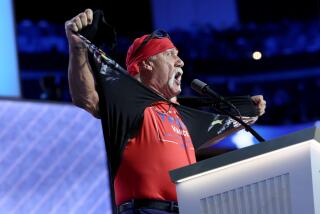Mr. Racquetball : Marty Hogan, Who Is in a League by Himself, Has Plans for a New Professional Tour
- Share via
If there were a “Who’s Who in Racquetball,” it would probably contain only one name: Marty Hogan. Everyone else is just plain who.
Oh sure, there are other good players, but ask the man on the street, and if he knows any racquetball player, he’ll know Hogan, the once brash, racquet-smashing teen-ager now a confident, astute young businessman.
Hogan, 29, is a six-time national champion and a five-time runner-up since 1976. He is professional racquetball’s first millionaire, and it will probably be some time before anyone else joins him.
His most recent national championship was in 1986, and this year he is in a good spot to win his seventh title, trailing Bret Harnett in the Racquetball Manufacturer’s Assn. pro tour standings by only two points with only the June 10-14 Head A’me Nationals left. In the late 1970s, when Hogan dominated his sport, he made the finals of 62 straight tournaments, winning 56.
His business statistics aren’t bad either. He has endorsed everything anyone could possibly use on the racquetball court. He has his own line of equipment. He has real estate holdings, including his own ranch outside St. Louis, his hometown. His book and video, “Power Racquetball,” have become the best-selling instructional tools in the sport.
These days, Hogan even co-sponsors his own amateur racquetball tournament series and has plans for a new professional tour that he says will rival the existing RMA-sponsored tour.
A simple case of Mr. Who’s Who trying to show the plain whos, who is who? Not quite.
First, for racquetball to advance beyond the private club, Hogan must play a role. Second, below the pro level, hardly anyone is arguing with Hogan. Racquetball has always been a game dominated by the businessman--or woman--with a yen for an hour of good physical exercise sandwiched between the 9-to-5 grind. The Coors-Marty Hogan Classic series, which benefits the Multiple Sclerosis Society, is aimed at bringing even more people into what has always been more a participant than a spectator sport.
One of the two opening-weekend events in the series is under way this weekend at the Santa Monica Athletic Club. The 14-tournament series excludes the top 40 professional players but is open to just about anyone else who cares to compete in any one of nine men’s, three women’s and two doubles divisions. There’s prize money for the winners of the open division, but this is basically a grass-roots event.
“The ultimate goal for this program is to have a national tour of charity events that, hey, I could sort of say we’re helping a lot of people, a lot of good causes,” Hogan said. “We want to keep it to a national participation kind of deal with fitness companies giving away stuff, some prize money to entice people, but this isn’t for the top dogs of the sport.”
For the top dogs of the sport, Hogan has other plans. Hogan said that on June 23 he will announce the formation of a new racquetball tour that will begin in September. The tour will be run in competition with the RMA-sponsored tour, also scheduled to begin its next season in September, sometimes competing for the same events.
Men’s professional racquetball, plagued by disorganization among its players and too many here-today-gone-tomorrow sponsors, is again in search of direction.
This year, for instance, Ektelon and DP, two of the major equipment makers, canceled their national tournaments, both top events on the RMA tour. The companies say that the decisions were based on business concerns and will not hurt the professionals, and RMA Commissioner Jim Hiser, though disappointed, said the cancellations do not signal the end for men’s professional racquetball.
Hogan, however, called the action the “biggest slap in the face men’s professional racquetball has ever gotten.
“They (Ektelon and DP) said they have better ways of spending money than on the professional game. They’re saying (to the pros), ‘You guys better make some abrupt turns.’ That’s the reason I’ve tried to organize the players, because otherwise they aren’t going to make a living.”
By establishing his new professional tour, Hogan said that he is merely trying to be good to a sport that has done a lot for him, to build a future for a great gym-rat game that has never had a lot of spectator attention.
“I don’t benefit one iota (from organizing a new tour),” Hogan said. “I’m already in good shape with the companies I represent. I want to save something that’s been really good to me.”
RMA Commissioner Jim Hiser doesn’t deny that Hogan should play a significant role in the professional sport’s future, but he wants Hogan to work within the current tour and players’ organization structure.
“Marty wants to have control, I think, of professional racquetball, to do some things that haven’t been done before,” Hiser said. “It would be better if he would work with the powers that are already working with racquetball.”
Said Hogan: “This is something I feel has to be done in order to save professional racquetball. The RMA has been given four years to prove if they can run the professional circuit. No. 1, they haven’t created the publicity. Nobody knows that professional racquetball exists. They’ve been unable to attract corporate sponsorship, and they have not helped putting up money for the local sites.
“Their intentions are good. Unfortunately, they are not sports promoters.”
And Marty Hogan is, of racquetball at least. He’ll tell you he’s not above the game, that professional racquetball will go on without him, but he also said he has a responsibility to the game, and he intends to go about fulfilling that responsibility his way.
“I’m not doing this because I want to take over,” Hogan said. “In no way, shape or form do I want to limit professional racquetball, but I want us to grow to be as big as we can. Quite frankly, I’m willing to make the changes and take the consequences. I’m willing to take any negative press (the RMA) gives me.”
For racquetball, negative press is better than no press at all. Then maybe someone else can make it into Who’s Who.
More to Read
Go beyond the scoreboard
Get the latest on L.A.'s teams in the daily Sports Report newsletter.
You may occasionally receive promotional content from the Los Angeles Times.










